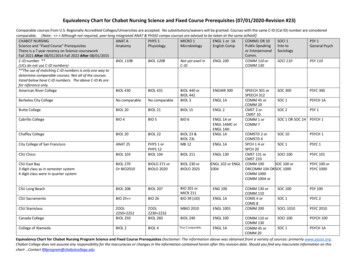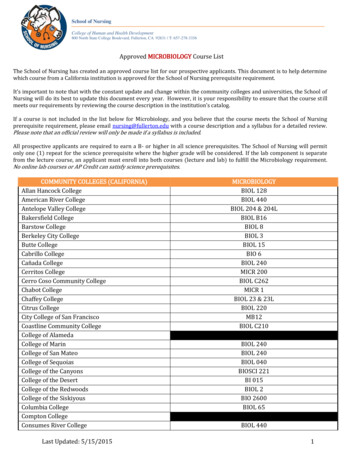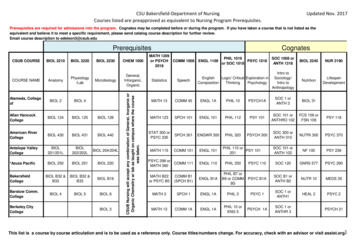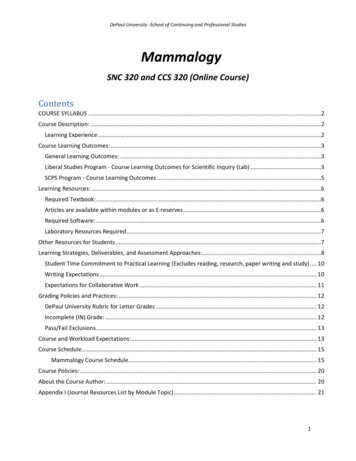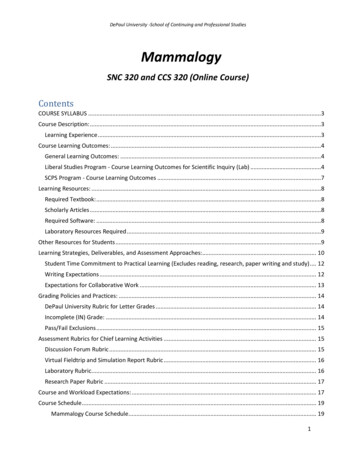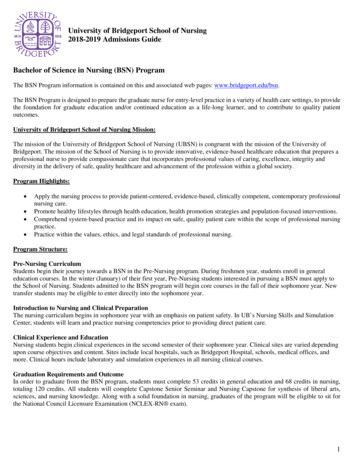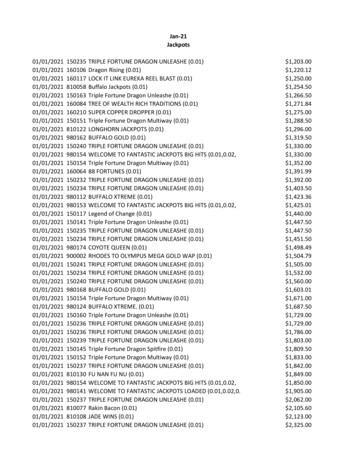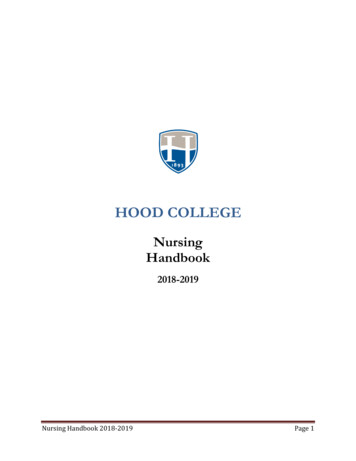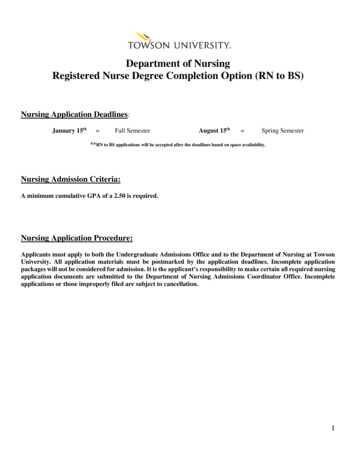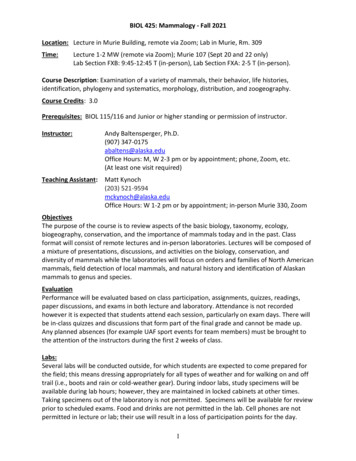
Transcription
BIOL 425: Mammalogy - Fall 2021Location: Lecture in Murie Building, remote via Zoom; Lab in Murie, Rm. 309Time:Lecture 1-2 MW (remote via Zoom); Murie 107 (Sept 20 and 22 only)Lab Section FXB: 9:45-12:45 T (in-person), Lab Section FXA: 2-5 T (in-person).Course Description: Examination of a variety of mammals, their behavior, life histories,identification, phylogeny and systematics, morphology, distribution, and zoogeography.Course Credits: 3.0Prerequisites: BIOL 115/116 and Junior or higher standing or permission of instructor.Instructor:Andy Baltensperger, Ph.D.(907) 347-0175abaltens@alaska.eduOffice Hours: M, W 2-3 pm or by appointment; phone, Zoom, etc.(At least one visit required)Teaching Assistant:Matt Kynoch(203) 521-9594mckynoch@alaska.eduOffice Hours: W 1-2 pm or by appointment; in-person Murie 330, ZoomObjectivesThe purpose of the course is to review aspects of the basic biology, taxonomy, ecology,biogeography, conservation, and the importance of mammals today and in the past. Classformat will consist of remote lectures and in-person laboratories. Lectures will be composed ofa mixture of presentations, discussions, and activities on the biology, conservation, anddiversity of mammals while the laboratories will focus on orders and families of North Americanmammals, field detection of local mammals, and natural history and identification of Alaskanmammals to genus and species.EvaluationPerformance will be evaluated based on class participation, assignments, quizzes, readings,paper discussions, and exams in both lecture and laboratory. Attendance is not recordedhowever it is expected that students attend each session, particularly on exam days. There willbe in-class quizzes and discussions that form part of the final grade and cannot be made up.Any planned absences (for example UAF sport events for team members) must be brought tothe attention of the instructors during the first 2 weeks of class.Labs:Several labs will be conducted outside, for which students are expected to come prepared forthe field; this means dressing appropriately for all types of weather and for walking on and offtrail (i.e., boots and rain or cold-weather gear). During indoor labs, study specimens will beavailable during lab hours; however, they are maintained in locked cabinets at other times.Taking specimens out of the laboratory is not permitted. Specimens will be available for reviewprior to scheduled exams. Food and drinks are not permitted in the lab. Cell phones are notpermitted in lecture or lab; their use will result in a loss of participation points for the day.1
Lecture ScheduleDateAug. 23Aug. 25Aug. 30Sept. 1Sept. 8Sept. 13Sept. 15Sept. 20Sept. 22Sept. 27Sept. 29Oct. 4Oct. 6Oct. 13Oct. 18Oct. 20Oct. 25Oct. 27Nov. 1Nov. 3Nov. 8Nov. 10Nov. 15Nov. 17Nov. 22Nov. 24Nov. 29Dec. 1Dec. 6 or 8TopicMammal characteristics, Why studymammals? Approaches to studyingmammalsBiodiversity and BiogeographyConservation of MammalsPhylogeny, Diversification and EvolutionDentition and Modes of FeedingEnvironmental AdaptationsEulipotyphlaRodentia and LagomorphaLocomotionReproduction and Sexual SelectionMidterm IMovement and Spatial PatternsProboscidea, Hyracoidea, and SireniaMonotremata; MarsupialiaChiropteraParasites and DiseaseGuest Lecture: Dr. Casey BrownPerissodactyla and CetartiodactylaPrimatesSocial BehaviorPopulation EcologyCommunity EcologyMidterm IIPilosa, Cingulata, Tubulidentata,Proboscidea, Hydracoidea, etc.Cetacea and PholidotaGuest Lecture: Dr. Lara Horstmann-DehnCarnivora I: Mustelidae, UrsidaeCarnivora II: Canidae, FelidaeGuest Lecture: Dr. Ken TapeEffects of climate change on mammalsLeftoversFinal Exam (TBD)2Readings Due (Feldhammer et al.)Chapter 1Chapter 5Chapter 28; Bowyer et al. 2019Chapter 3, Chapter 4 (pp. 60-73)Chapter 4 (pp. 74-77), Chapter 7Chapter 8Chapter 17Chapter 18, Chapter 2Chapter 6Chapter 9; Chapter 22Chapter 24Chapter 12Chapter 10Chapter 21Chapter 27; Rocha et al. 2020Chapter 19Chapter 15Chapter 23Chapter 25Chapter 26Chapters 11, 12, 13Chapter 20 and Chapter 18 (pp. 398401)Chapter 18 (pp. 376-397)Eeden et al. 2018Pacifici et al. 2018
Lab ScheduleDateTopicAug. 31UA Museum of the North tour. IACUC OverviewSept. 7Rodentia, Lagomorpha skins and skulls*Sept. 14Set small mammal traps*Sept. 21Check small mammal traps; powder tracking*Sept. 28Squirrel trapping and deploy remote cameras and temperature loggers(*) Oct. 5Eulipotyphla skins and skulls (or field bat detection)*Oct. 12LARS: caribou, reindeer, and muskox identification, physiology, and behaviorOct. 19Lab Exam IOct. 26Artiodactyla, Perissodactyla skins and skullsNov. 2Chiroptera and Primates, echolocation, skins and skullsNov. 9Monotremata, Marsupialia skullsNov. 16Pilosa, Cingulata, Tubulidentata; Proboscidea, etc. skulls*Nov. 23Snow tracking, retrieve cameras and temperature loggersNov. 30Carnivora, review camera imagesDec. 6Lab Exam II*Denotes field activity outside. Please dress appropriately and come prepared!Grading policy:Final grade will be calculated as follows: Lecture (60%); Lab (40%).Letter grade: A (100-90); B (89-80); C (79-70); D (69-60); F (below 60).The letter “I” (Incomplete) is a temporary grade used to indicate that the student hassatisfactorily completed (C or better) the majority of work in a course but for personal reasonsbeyond the student’s control, such as sickness, has not been able to complete the course duringthe regular semester. Negligence or indifference are not acceptable reasonsfor an “I” grade.”Components of grade:Item1. Midterm I2. Midterm II3. Final4. Lab exam I5. Lab exam II6. Lecture assignments (quizzes, participation)7. Lab assignments (Field notes, quizzes, etc.)DateSept. 29Nov 8Dec 6Oct 19Nov 30DailyDaily% of grade15151515151015Extended absence policy: The University of Alaska Fairbanks recognizes that students may needto miss more classes than allowed by a particular instructor as specified in course policies.Extended absences are defined as missed classes or course work by students beyond what ispermissible by the instructor’s written course policies. Students may need to miss class and/orcourse work for a variety of reasons, including, but not limited to: Bereavement Personalillness or injury Serious illness of a friend, family member or loved one Military obligations Jury service Other emergency or obligatory situations For more information, go to theStudents Handbook or the Center for Students Rights and Responsibilities3
Notes (These correspond to item numbers listed in the above table.)2,3Midterm II and Final will not be comprehensive but could include questions aboutlinkages between concepts and materials covered earlier in lecture and those coveredsince the previous exam.4,5Lab tests will focus on identifying distinguishing characteristics of orders and familiesand identifying Alaskan and North American specimens to genus and species. They willalso cover any field exercises to date.6.There will be unannounced short quizzes, and discussion readings in lecture. You will beexpected to come to class with a short list of written comments and questions about thereading assigned for that lecture.7.There will be assignments for field observations near the Irving Building that you will bedoing in small groups outside of the lab and lecture time periods.Required ResourcesTextbook: Feldhamer, G.A. et al. 2020. Mammalogy. 5th edition Johns Hopkins UniversityPress. (Previous editions ok, but taxonomy changes over time!)Additional readings: These will be posted on Canvas (canvas.alaska.edu ) before assigned dates.Optional ResourcesCooke, J.A. and MacDonald, S.O. Recent Mammals of Alaska. University of Alaska PressPatton, J. 2011. A Lab Manual for Mammalogy. UC Berkeley PressMacDonald, S.O. 2002. A field handbook of the shrews and small rodents."Life of Mammals" film series by David AttenboroughMammalian Species Accounts (American Society of ents/Biology/VHAYSSEN/msi/Animal Diversity Web (Museum of Zoology, University of e/index.htmlGlobal Biodiversity Information Facility (GBIF)http://www.gbif.orgInternational Union for Conservation of Nature Redlist (IUCN)http://www.iucnredlist.org/Encyclopedia of Lifehttp://www.eol.org4
How to get helpMy primary role in this course is to help you understand biology; I want to help you. I amunlikely to know if you are having difficulties with the course material unless you tell me. Iwould love to see everyone do well in the course. Ultimately, however, how well you do in theclass is up to you. If you have questions or are finding that you are struggling with a particulartopic, assignment or question, please ask. There are several ways to get help in this course: If you have a question during lecture, please ask. Jump in, raise your hand, or type aquestion in the chat window. If one student is confused, usually other students are too.This also helps inspire discussions. Talk to me after lecture or during office hours, or make an appointment. Email me. I’mhappy to answer your questions in a timely manner. Talk to your TA. Talk to your classmates Setting up study groups and explaining things to each other can bevery helpful. You can communicate with classmates via CircleIn (circleinapp.com).UAF Student Academic Support: Speaking Center (907-474-5470, uaf-speakingcenter@alaska.edu, Gruening 507) Writing Center (907-474-5314, uaf-writing-center@alaska.edu, Gruening 8th floor) UAF Math Services, uafmathstatlab@gmail.com, Chapman Building (for math fee payingstudents only) Developmental Math Lab, Gruening 406 The Debbie Moses Learning Center at CTC (907-455-2860, 604 Barnette St, Room nt-success-center/) For more information and resources, please see the Academic Advising Resource List(https://www.uaf.edu/advising/lr/SKM 364e19011717281.pdf)Progress ReportsUAF instructors are utilizing a student performance notification process also known as progressreports (e.g., via Nanook Navigator; uaf.edu/gs/nanooknavigator). This process allowsinstructors to notify students and advisors when we have positive feedback, concerns aboutyour progress or any barriers you may be facing in this course so that any issues can beaddressed and fixed. Receiving a performance notification does not mean your instructor thinksyou should drop the course; it does mean that you should reach out to your instructor. Even ifyou didn’t receive an email and you are concerned about any of your courses please reach outto your instructors or advisor. Advisors and the instructors are here to support you throughyour courses and the semester.The performance notifications are near the add/drop deadline and before the withdrawaldeadline, please contact an advisor or me before dropping this course.Academic DishonestyActs of academic dishonesty include cheating on exams, helping others to cheat, plagiarizing,feigning illness to obtain an extension, and turning in work that was written for another classwithout permission. Please read the UAF Student Code of Conduct in the UAF Catalog.Students who behave dishonestly will receive an F for the class and the case will be presentedto the University Disciplinary and Honor Code Committee for review. Students are encouragedto work groups on lab exercises, but unless otherwise specified, each student must turn in hisor her own written assignment.5
COVID-19 statement: Students should keep up-to-date on the university’s policies,practices, and mandates related to COVID-19 by regularly checking this virus/uaf?authuser 0Further, students are expected to adhere to the university’s policies, practices, and mandatesand are subject to disciplinary actions if they do not comply.Student protections statement: UAF embraces and grows a culture of respect, diversity,inclusion, and caring. Students at this university are protected against sexual harassment anddiscrimination (Title IX). Faculty members are designated as responsible employees whichmeans they are required to report sexual misconduct. Graduate teaching assistants do notshare the same reporting obligations. For more information on your rights as a student and theresources available to you to resolve problems, please go to the following /students-rights-responsibilities/.Disability services statement: I will work with the Office of Disability Services to providereasonable accommodation to students with disabilities.Student Resources: Disability Services (907-474-5655, uaf-disability-services@alaska.edu, Whitaker 208) Student Health & Counseling [6 free counseling sessions] (907-4747043, https://www.uaf.edu/chc/appointments.php, Whitaker 203) Center for Student Rights and Responsibilities (907-474-7317, uafstudentrights@alaska.edu, Eielson 110) Associated Students of the University of Alaska Fairbanks (ASUAF) or ASUAF StudentGovernment (907-474-7355, asuaf.office@alaska.edu, Wood Center 119)Nondiscrimination statement: The University of Alaska is an affirmative action/equalopportunity employer and educational institution. The University of Alaska does notdiscriminate on the basis of race, religion, color, national origin, citizenship, age, sex, physical ormental disability, status as a protected veteran, marital status, changes in marital status,pregnancy, childbirth or related medical conditions, parenthood, sexual orientation, genderidentity, political affiliation or belief, genetic information, or other legally protected status. TheUniversity's commitment to nondiscrimination, including against sex discrimination, applies tostudents, employees, and applicants for admission and employment. Contact information,applicable laws, and complaint procedures are included on UA's statement of nondiscriminationavailable at www.alaska.edu/nondiscrimination. For more information, contact:UAF Department of Equity and Compliance1760 Tanana Loop, 355 Duckering Building, Fairbanks, AK 99775907-474-7300uaf-deo@alaska.edu6
1 BIOL 425: Mammalogy - Fall 2021 Location: Lecture in Murie Building, remote via Zoom; Lab in Murie, Rm. 309 Time: Lecture 1-2 MW (remote via Zoom); Murie 107 (Sept 20 and 22 only) Lab Section FXB: 9:45-12:45 T (in-person), Lab Section FXA: 2-5 T (in-person). Course Description: Examination of
